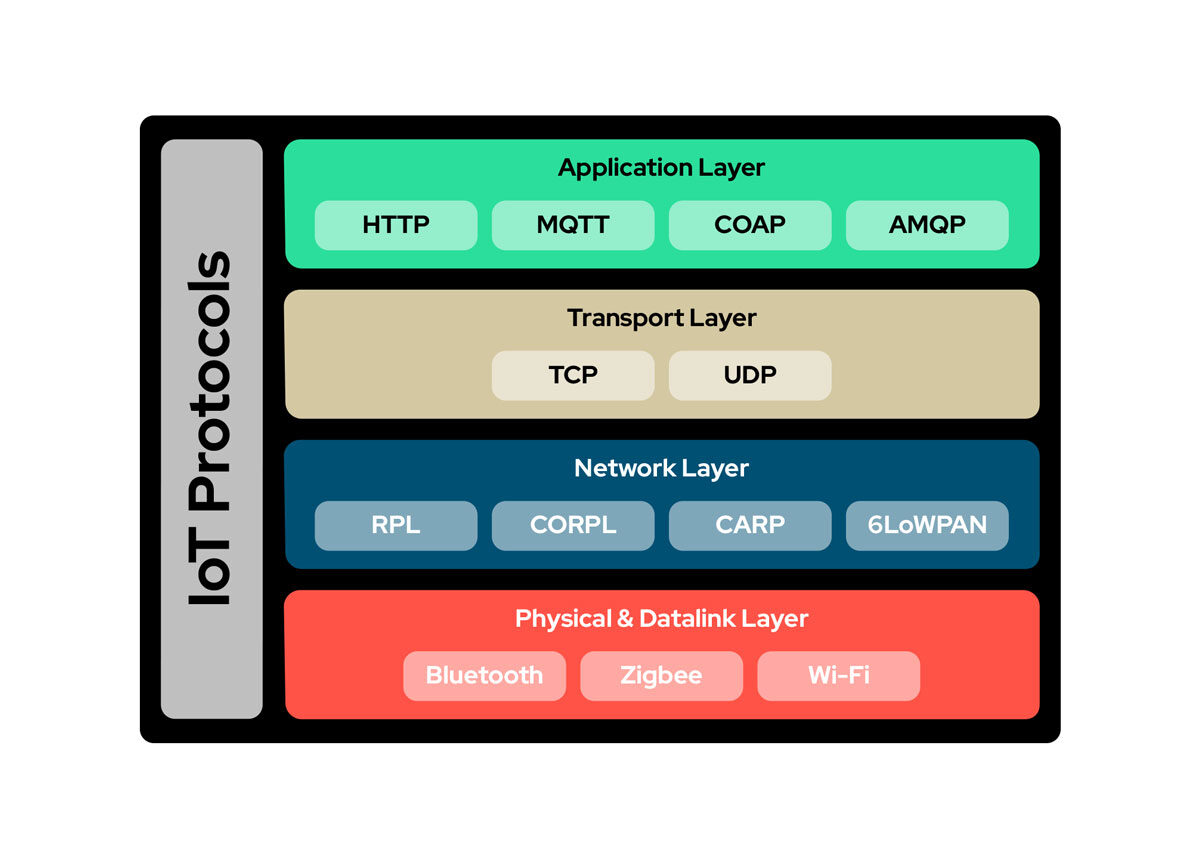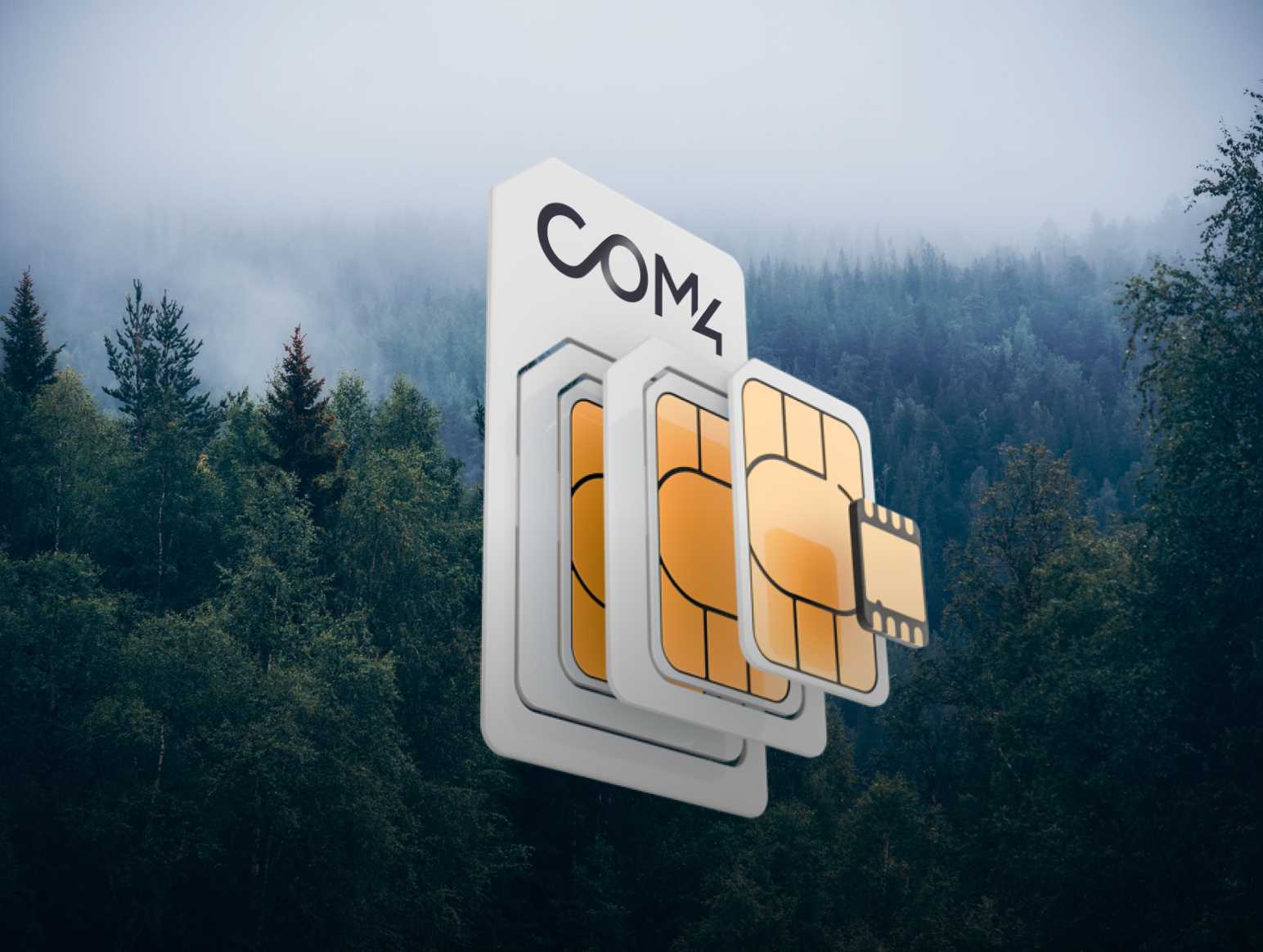More often than not, the industry has its attention firmly fixed upon communication. While the interaction among devices, IoT sensors, gateways, servers, and user applications is essential to IoT, communication would fall down without the right IoT protocols.
The Role of Protocols in IoT
Protocols serve as a shared language for network entities like servers, gateways, routers, applications, and connected IoT devices to interact. A protocol outlines a set of rules that both parties must follow to communicate effectively. These rules dictate the nature of their interactions, the values and attributes transmitted, the methods for receiving and processing data, the security measures employed, and more.
IoT protocols are an integral part of the IoT technology stack. Without IoT protocols and standards, hardware would be useless. This is because IoT protocols enable the exchange of data and commands among various devices, allowing end users to extract useful information and interact with and control devices.
Why Are IoT Protocols Important?
IoT protocols are crucial for the functionality and interoperability of IoT systems. They ensure that communication among devices is standardized, reliable, and secure, enabling different devices and systems to work together seamlessly. The protocols you choose determine your application's complexity and help prioritize service and performance qualities such as speed, clarity, power conservation, and security.
How Many IoT Protocols Are There?
In short, a lot. The IoT is heterogeneous, involving various smart devices, protocols, and applications. Different projects and use cases require different devices and protocols. For example, an IoT network collecting weather data over a wide area needs numerous low-power sensors, prioritizing energy efficiency over speed or security. Conversely, an IoT system with medical sensors on ambulances transmitting patient data to hospitals must prioritize speed and security, requiring more powerful and secure protocols.
Experts have categorized IoT architecture into different layers to simplify maintenance and promote interoperability. One of the best frameworks for understanding IoT layers is the Open Systems Interconnection (OSI) model, which defines seven layers in a top-down architecture.
OSI Model Layers
-
Physical Layer: Consists of hardware like ethernet cables and cell towers.
-
Data Link Layer: Corrects errors and links devices for data transfer.
-
Network Layer: Coordinates data transfer and routes packets.
-
Transport Layer: Transports data packets.
-
Session Layer: Schedules communication sessions between devices.
-
Presentation Layer: Encrypts and transforms data for readable presentation in the application layer.
-
Application Layer: Encompasses mobile and web applications interacting with IoT devices.
Experts also simplify IoT architecture into three, four, or five-layer models, each comparable to the OSI construct. For instance, a three-layer model includes the application, network/internet, and perception/sensing layers. A four-layer model adds the transport layer, and a five-layer model includes a business/data analytics layer for actionable insights.
Categories of IoT Protocols
-
IoT Application Protocols
-
Industry-Specific IoT Application Protocols
-
IoT Protocols for Consumer Devices
-
IoT Transport Protocols
-
Network Layer IoT Protocols
-
Physical and Data Link Layer IoT Protocols
-
IoT Security Protocols
For expert advice on how your IoT connectivity solution influences protocol choices, consult with our specialists.
IoT Application Protocols
MQTT (Message Queueing Telemetry Transport)
MQTT is a lightweight communication protocol designed for IoT and M2M applications, ideal for remote environments or limited bandwidth. It uses a publish/subscribe architecture, where applications can publish or subscribe to topics, and an MQTT broker facilitates information transfer.
Example: A predictive maintenance sensor on an oil rig detects changes in vibrations and publishes the data via MQTT. The MQTT broker passes this data to a subscribed application, triggering alerts when necessary.
HTTP (HyperText Transfer Protocol)
HTTP is widely used for web navigation and REST-APIs, allowing web developers to send data via HTTP POST requests. Despite its connectionless nature and higher data consumption, HTTP is suitable for use cases with fewer data and battery constraints.
WebSocket
WebSocket is a bi-directional communication protocol that allows real-time data transmission with low latency and minimal overhead, making it suitable for IoT applications requiring frequent, high-volume data exchanges.
AMQP (Advanced Message Queuing Protocol)
AMQP is an open-source protocol designed for interoperability between systems, devices, and applications. It offers more routing options than MQTT but comes with increased complexity and overhead.
CoAP (Constrained Application Protocol)
CoAP is designed for low-power, lossy networks and is often paired with UDP for efficiency. It's suitable for applications like smart meter communications, where battery conservation is crucial.
LwM2M (Lightweight Machine-to-Machine)
Building on CoAP, LwM2M provides efficient low-power communication along with device management and provisioning functionalities, using protocols like UDP, TCP, and SMS for data transport.
XMPP (Extensible Messaging and Presence Protocol)
XMPP, built on XML, was initially for instant messaging but now facilitates well-structured data communication between platforms, despite being less optimized for memory-constrained devices.
DDS (Data Distribution Service)
DDS is a real-time, interoperable protocol for reliable, distributed processing between devices. It uses a publish/subscribe mechanism with direct peer-to-peer data exchange, supported by TCP and UDP.
SMS / SMPP (Short Message Peer-to-Peer Protocol)
SMS allows data exchange over cellular connections, and SMPP facilitates programmatic communication with devices via service providers' SMS Centers.
USSD (Unstructured Supplementary Service Data)
USSD, or "Feature Codes," retrieves text-based data from IoT devices without a data connection. However, it is becoming obsolete as carriers phase out 2G and 3G networks.
Simple Sensor Interface (SSI) Protocol
SSI enables simple, low-power communication between IoT sensors and terminals, but its lack of updates since 2006 may render it obsolete.
Industry-Specific IoT Application Protocols
OCPP (Open Charge Point Protocol)
OCPP is an open standard for EV charging stations, facilitating communication with a central system for security, transactions, diagnostics, and device management.
IEC 62056
This set of standards by the International Electrotechnical Commission defines data exchanges for electricity meters, aiming for international standardization.
OBD2/CAN Bus
OBD2 and CAN Bus protocols define communication between vehicle systems and diagnostic ports, commonly used for capturing vehicle telematics information.
OPC UA
OPC Unified Architecture is a versatile, interoperable protocol for industrial IoT, facilitating data exchange between connected sensors and the cloud.
Wireless M-bus
This European standard is designed for smart meter communication, offering good indoor penetration and wide adoption in Europe despite lacking a certification standard.
IoT Protocols for Consumer Devices
Matter
Developed by Google, Apple, Amazon, Samsung SmartThings, and the Zigbee Alliance, Matter enhances compatibility between smart home devices from different vendors.
Weave
Initially for Nest products, Weave (acquired by Google) facilitates IoT communication over various network types, including Ethernet, Wi-Fi, and Bluetooth Low Energy.
Homekit Accessory Protocol (HAP)
Apple's HAP enables third-party devices to communicate with Apple products, allowing control of smart home devices through Apple interfaces.
KNX
An open standard for building automation, KNX operates over various links and is derived from several European protocols.
X10
Developed in 1975, X10 remains in use for remote control of household devices via Power Line Communication (PLC) and RF.
Z-Wave
A smart home protocol using mesh networking to connect devices to a central hub, Z-Wave offers longer range than Bluetooth and lower power consumption than Wi-Fi.
IoT Transport Protocols
UDP (User Datagram Protocol)
UDP prioritizes speed over reliability, making it ideal for time-sensitive applications like video streaming and VoIP.
TCP (Transmission Control Protocol)
TCP ensures accurate data delivery, prioritizing reliability over speed, suitable for applications where data integrity is crucial.
Network Layer IoT Protocols
IP (Internet Protocol)
IP assigns addresses to network entities, enabling data packet routing across different networks.
Physical and Data Link Layer IoT Protocols
Wi-Fi
Wi-Fi creates Local Area Networks for device connectivity but may not be ideal for IoT due to signal interference and higher power consumption.
LTE (Long Term Evolution)
LTE provides high-speed data for multimedia applications but is costly and unsuitable for battery-powered IoT devices. LTE CAT-1 offers a simpler, less expensive alternative.
GSM
Despite its age, GSM remains widely used for IoT due to its simplicity and affordability, though its future is uncertain as 2G networks phase out.
GPRS
An enhancement to 2G, GPRS offers higher data rates and always-on Internet access.
UMTS
Synonymous with 3G, UMTS provides greater bandwidth and efficiency than GSM but faces obsolescence as carriers sunset 3G networks.
5G
5G promises ultra-fast data speeds but is still early for IoT use due to device costs and energy consumption.
NB-IoT
NB-IoT is an affordable cellular LPWAN technology known for its long battery life and superior signal penetration, making it ideal for IoT devices in hard-to-reach areas like subterranean, indoor, and rural locations. Its low power consumption and wide area coverage result in significant cost savings for businesses in data and device management.
LTE-M
LTE-M (Long-Term Evolution for Machines) is a highly efficient communication technology that offers low power consumption, wide coverage, and high reliability, making it ideal for IoT devices. It supports devices with low power requirements, allowing them to operate for years on a single battery charge, even in remote and hard-to-reach locations. LTE-M provides secure communication channels, building on the modern security standards of LTE networks, and is cost-effective due to its minimal infrastructure needs. This technology is well-suited for various applications, including smart cities, logistics, and industrial manufacturing, enhancing operational efficiency and enabling real-time asset monitoring.
NFC (Near Field Communication)
NFC enables close-range connectivity, facilitating tap-to-pay and similar applications.
PLC (Power Line Communication)
PLC uses existing power lines for data transmission, offering a simple but unreliable connectivity solution.
MIoTy
MIoTy uses telegram splitting and error correction for efficient, large-scale industrial IoT connectivity.
LoRa and LoRaWAN
LoRa provides robust signal strength and security, while LoRaWAN connects devices to a network, suitable for low-power, wide-area IoT applications.
Sigfox
Sigfox offers long-range, low-data communication, suitable for simple IoT applications but limited by its small message size.
Neocortec
Neocortec's mesh networking protocol emphasizes simplicity and reliability, requiring manufacturers to manage their own infrastructure.
Weightless
Weightless, an LPWAN technology, offers efficient, collision-free data transmission over long distances, though only the Weightless-P standard is actively developed.
IoT Security Protocols
IPSec (Internet Protocol Security)
IPsec secures network communications at the IP layer, suitable for powerful gateways but not for low-resource IoT devices.
OpenVPN (Open Virtual Private Network)
OpenVPN creates secure VPNs, essential for remote maintenance and troubleshooting of IoT devices.
TLS (Transport Layer Security)
TLS secures Internet communications by authenticating clients and servers and encrypting data transmissions, relying on certificate authorities for device authenticity.
Getting Started with IoT Connectivity
Com4 offers global IoT connectivity with multi-layered security. Our IoT SIMs connect to over 750 networks in more than 190 countries, providing flexible, scalable solutions. As you examine the protocols and standards your application needs, consider the possibilities of cellular IoT. Our IoT experts will be happy to talk through the best options for your solution.
For personalized advice on your IoT connectivity needs, contact our experts and discover how Com4 can support your business growth.

 CASE STUDY
CASE STUDY






.png)

